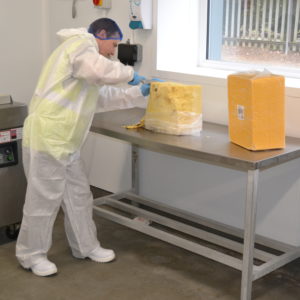At Edwards Transport, our food grading and sampling facility provides customers with a spacious hygienic environment in which to conduct sampling and grading activities.
What is Food Grading?
Food grading is the process of accessing and inspecting various foods. The food grade system applies to both food and non food items that;
- Are safe to consume.
- Can contact food while remaining safe
The inspections and assessments involve grading the food for:
- Quality
- Freshness
- Legal conformity
- Market value
Want to be Food Grade Compliant?
Different types of food can be graded to different standards. Food such as dairy products involve observing certain criteria.
Dairy grading can be done using the five senses, mainly taste and smell. However, technical testing also has to be completed. This comprises of:
- Receiving a sample of the product – making sure that it is in sterile packaging.
- A grader who will follow the latest “Standard Methods for the Examination of Dairy Products’
- The dairy product will then undergo a variety of tests.
All of the tests carried out ensure that food safety and food hygiene standards are met.
Although constructed with the cheese and dairy industries in mind our food grading facility is adaptable and can be used for a number of food based services.
Furthermore, within the same facility we are able to offer cheese cleaning and repacking facilities to our clients.
Beef Food Grading
Grading Beef involves observing the criteria of The Beef Carcase Classification scheme: classify carcases.
This comprises of:
- Dressing the carcase
- Categorising the carcase
- Classifying the carcase – According to conformation (flesh coverage and overall shape), fat coverage and weight.
- Stamping or labelling the carcase
- Communicate the classification results
Grading by hand
Food grading such as the inspection of fruits after washing can be done by hand. The effectiveness of hand grading depends on a number of things:
- The quality of the product
- The quantity of product per inspector
- The Inspectors experience and physical condition
- The kind of inspection that is taking place– larger quantities of product such as grain, is graded on smaller random samples.
- The speed that the products pass the inspector – This is specific to the type of product
Grading by machinery
Food grading by machinery can generally be more efficient, especially for companies, which have a larger quantity of products.
The quality and freshness of a product can be graded by colour measurement, use of x rays, lasers and infrared rays as well as microwaves.
Machinery can also be used when sorting food. Sorting machinery can sort food based on their:
- Shape
- Size
- Density
- Surface properties
For more information on our food grading and sampling service please contact us.











